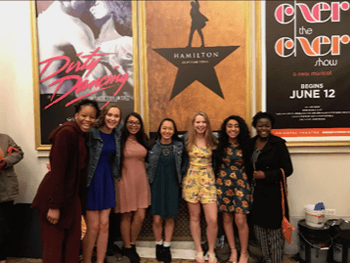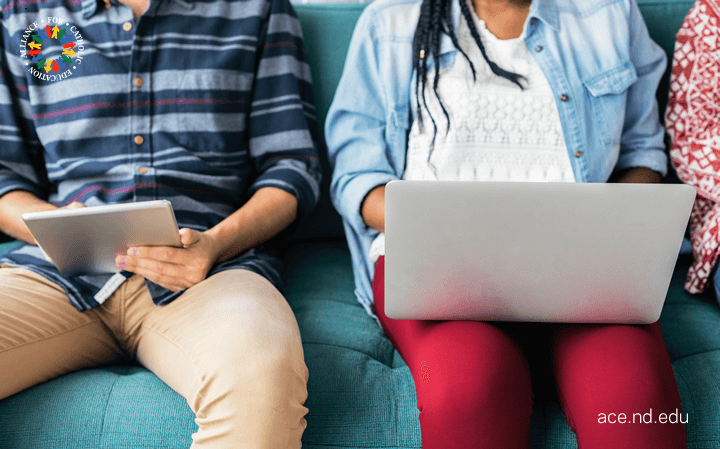The Higher-Powered Learning team is growing, and we are excited to introduce you to our newest member, Francesca Varga! Francesca was a teacher and instructional leader for nine years before joining us at ACE this summer. She has extensive experience with blended and personalized learning at the middle and high school levels. Below is Francesca's first contribution to our blog–but certainly not her last!
We often preface the concept of blended learning by citing the need to fill students' learning gaps through data-informed instruction. However, in my nine years of teaching, I have found that culture and building community and strong relationships with students is essential to the success of blended learning, and of learning more broadly. Here is a quick glimpse into my inspiration for implementing blended learning in my classroom and the students who made it possible...
 "Ohana means family, nobody gets left behind or forgotten"
"Ohana means family, nobody gets left behind or forgotten"
This sweet quote from Disney's Lilo and Stitch often resonated through the walls of Room 193, the Early College Cohort English classroom at a high school not far from Notre Dame's campus in Mishawaka, Indiana. The group was composed of ethnically diverse, mostly first-generation college, free-and-reduced-lunch-qualifying students. They came from a variety of cultures, home lives, and academic levels; some on grade level, many below; some with strong families; some whose families immigrated just years before; others who were "parenting" many young siblings at home; and others just struggling to survive.
My first few days with these students proved to be some of the most challenging days of my teaching career. I was overwhelmed with the gaps in learning and the diverse needs in a single classroom, not to mention the walls and trust issues these kids carried. Never would I have known at the time that these very kids would change me over the next two years and teach me more about life, love, and education than I ever could have imagined.
Our first year together brought many challenges, the deaths of loved ones, tragedies, and life-altering events that would normally break a young person. Instead of falling apart, though, my students chose to bond and create our own "family." They quickly learned that they were much more similar than different, and slowly walls were replaced with strong friendships and a support system so many desperately needed. Over fall break, one of my students, who was battling depression and had lost his father two years earlier, wrote, "Ohana means family. Nobody gets left behind or forgotten‚ all on the board. When one of my other students asked about it, the student replied, "This is family. This is my home." To my surprise, most of my students chimed in or nodded their heads in agreement. It was then that I realized that this "Ohana," my home away from home, was my family, too.
 From that moment on, I chose to teach my kids first, and I refused to allow data to "drive" my instruction for all of the reasons Elizabeth outlined in this post. Many of my students did not have parents at home or a strong support system, so we became our own support system. As a result, I got to know all 125 of my students as much more than data points. I learned their courageous stories, their dreams and aspirations, their fears, their hopes, their passions, and their pet peeves. I figured out how they learned best and the big "WHY" behind their individual gaps (or "Tetris gaps") so that we could create plans to fix them. The diverse learning gaps students exhibited called for a different approach to teaching and learning rather than the traditional "sage on a stage"/direct instruction teaching model. Blended learning proved to be the key to filling these individual gaps – and thus began my learning and growth along with my students.
From that moment on, I chose to teach my kids first, and I refused to allow data to "drive" my instruction for all of the reasons Elizabeth outlined in this post. Many of my students did not have parents at home or a strong support system, so we became our own support system. As a result, I got to know all 125 of my students as much more than data points. I learned their courageous stories, their dreams and aspirations, their fears, their hopes, their passions, and their pet peeves. I figured out how they learned best and the big "WHY" behind their individual gaps (or "Tetris gaps") so that we could create plans to fix them. The diverse learning gaps students exhibited called for a different approach to teaching and learning rather than the traditional "sage on a stage"/direct instruction teaching model. Blended learning proved to be the key to filling these individual gaps – and thus began my learning and growth along with my students.
Thanks to community-building activities, blended learning, project-based learning, field trips, out-of-the-classroom experiences, a little faith, and a lot of love, miracles occurred in Room 193. Students who had previously struggled to read at a second-grade level quickly filled their gaps and started to catch up; others who had never passed a standardized test exceeded the pass score on their dual-credit college placement exams at the end of freshman year; and still others exceeded the goals they set for themselves at the beginning of the year.
But more important in many ways than the academic growth was the personal growth I witnessed. For the first time in many of their lives, students were achieving! With blended learning, the idea that "...no one gets left behind or forgotten" became a reality.
The flexibility and freedom provided by blended learning allowed me to truly invest in my students as individuals. I learned the values of patience and perseverance. I learned the importance of appreciating the little things and taking time to celebrate each victory, regardless of how small it may seem. And most importantly, I learned to believe in the potential in each student and in the sheer power of love that transformed my students, not just academically, but as whole people.
 Alliance for Catholic Education
Alliance for Catholic Education
